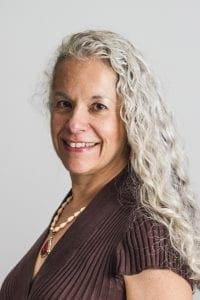Unlike most mainstream classrooms in other disciplines, in the language classroom, all the instruction teachers give, every task students do, and all text, media, and material with which they engage, must be considered through the lens of students’ language level. Language teachers shared a few creative ways to make the QFT accessible to students at varying levels of proficiency.
Use pre-teaching or scaffolding to adapt the QFT for beginner language students.
Leticia Quiles says, “The QFT can be modified for all levels, including beginner language students. The QFT would be an excellent way to teach beginner students the proper grammatical structure for interrogative statements, for example. The teacher can provide prompts such as “¿Qué es ______?” “¿Cómo es ______?” etc. Beginner students can also work with thematic vocabulary lists, that tie in with a prompt.”
Other teachers get students ready to engage by pre-teaching question words and structures prior to using the QFT.
Beth Skelton has students brainstorm questions in the target language before starting a QFT. The first time she introduces the QFT, she asks students just to think of all the questions they know how to ask in the target language. Even beginners know how to ask “What’s your name?” “How old are you?” “What is that?” etc. Without a QFocus, they can freely brainstorm any question to focus on the skill of question formulation in the target language. Then, that activity becomes a formative assessment for the QFT and the teacher can try to align the QFocus prompt with some of what students already know. Skelton says students know more questions than they think, because “they’re getting asked questions all the time.”
You can read more about scaffolds and adaptations that can be applied to the QFT here.
Decide strategically when to use students’ native language.
As mentioned in a previous blog, Judy Wilson suggests there are times you might allow, or want, students to ask questions in their native language.
She describes how a QFT lesson conducted in English was one of the most impactful for students. It was an interdisciplinary examination of Spanish art in a unit about identity. “In one particular lesson using the QFT, I presented my 7th grade students with a famous Goya portrait of a little 4-year-old boy adorned by finches. It was painted in 1788 and is known as ‘Boy in Red.’ The painting was the springboard for dozens of questions. Unbeknownst to me, their art teacher had planned a trip to the Metropolitan Museum of Art in New York City as a culminating activity for her own unit of study. She was excited to tell me that students chose to forego their time in the gift shop and instead find their way to the European wing where the ‘Boy in Red’ is displayed. Their teacher was beyond impressed of their knowledge of the painting and their excitement in seeing it firsthand. And it just goes to show you can make the bottom of your shoe interesting if you present it in a manner that engages students.”
Skelton suggests using a mix of the native and target language within the QFT process itself. Students can practice producing questions in the target language, as well as categorize their questions into open- and closed- ended–“Even beginners can sort!” Skelton says. The parts that likely require the native language are explaining the differences between open- and closed- questions and reflecting at the end. Teachers can make adjustments like these to different steps of the process depending on the proficiency level of their students.
Other language teachers have sometimes used the QFT as an opportunity to practice translation into the target language, after students have produced and worked with questions in their native language.
Have students ask questions in any way they know how.
Quiles and Wilson agree that students at any level can use the QFT by practicing communicating in any way they know how, without fear of judgment. Quiles says, “Clearly teachers need to provide more vocabulary and grammar frameworks for beginner students, than for intermediate and advanced,” but “students also need to circumlocute and figure out a way to ask and/or answer the question, even if they don’t know a specific word. They must find a way to engage in conversation, without using their teacher as a human dictionary.”
Wilson explains further, “Think of how a child learns language. They aren’t born asking questions in complete sentences. They little by little learn to grasp language at first informally by using hand signals, body language, baby talk, and by mimicking. As they become proficient in the world around them, their speech becomes more and more sophisticated. As in the language classroom, you start out with simple sentences and then progress to more complex.” She concludes, “The kids should not be discouraged from asking questions because they don’t have the grammar for it yet. You can’t get hung up on that. They have questions. Just let them ask away.”
And, with students of any level who are practicing using language in a new way, don’t correct them on grammar.
During the process, that is. Quiles and Wilson agree: Correcting or assessing students for accuracy of grammar while doing the QFT can undermine their ability to freely ask questions. Quiles writes, “The question ‘If they make grammar mistakes, should I correct them?’ is highly debated among World Language teachers. I personally do not correct students when they are in the process of exploration and self-expression. In my opinion, if they feel every word out of their mouth, or off their pen/pencil, is subject to instant critique, they will be inhibited. I encourage my students to just talk. Grammar correction is primarily during periods of express instruction and by modeling.”
Similarly, Wilson says: “We do focus on direct instruction of grammar of course, but I believe we shouldn’t penalize students for it. When you correct their grammar, you halt that communication. If you want to them to try to communicate, you need a to encourage a culture where students are brave enough to speak freely in the target language without fear of being told they are wrong. They need to be comfortable enough to take that chance.”
Armed with all of these insights, I am left with the conclusion that when it comes to teaching students to ask their own questions in the language learning classroom, there are decisions to be made and sometimes trade-offs, but it can be done and have an amazing impact on students. Ultimately, it means deciding that students learning to ask questions, and students’ genuine curiosity as the starting point for all learning is important enough— to carve time out, to make adaptations, and to use all of students’ language resources.
Click here to read part 1 of this blog: “Mastering the Art of Communication”: Student Questions in the Language Classroom.
We are still learning about the use of the QFT in the language classroom from educators in the field and would love to hear from you! Please send us at email at contact@rightquestion.org if you have an example you’d like to share.

Leticia Quiles has been a teacher for over 15 years. She is presently a member of the World Language Department at Bishop Guertin High School in Nashua, New Hampshire, where she has taught college-prep, honors, pre-AP, and AP Spanish Language and Culture. Leticia also moderates the Spanish National Honor Society and is the Professional Development Chairperson. Leticia is also the first teacher in the state to teach AP Capstone. Leticia graduated from Cornell University with a double major in Biology and Psychology, and a double minor in Chemistry and Spanish. She earned her Masters Degree in Spanish from Rivier University. Leticia is also the Director of Mainely Rat Rescue, a non-profit small animal rescue organization.
 Judith Wilson is currently a consultant for The Executive Leadership Institute, an affiliate of the Council for Supervisors and Administrators in New York City. She works as mentor for new school administrators, presents at national conferences, and helps schools learn how to communicate their vision and values to the school community. Judith spent her education career working for the New York City Department of Education as a teacher and assistant principal in middle school level and as a principal at the elementary school level. Her teaching and instructional background includes teaching World Languages (Spanish and Italian) and English Language Arts. Judith recently presented The Question Formulation Technique to World Language Teachers at the 2019 ACTFL American Council of Teachers of Foreign Language conference in New Orleans.
Judith Wilson is currently a consultant for The Executive Leadership Institute, an affiliate of the Council for Supervisors and Administrators in New York City. She works as mentor for new school administrators, presents at national conferences, and helps schools learn how to communicate their vision and values to the school community. Judith spent her education career working for the New York City Department of Education as a teacher and assistant principal in middle school level and as a principal at the elementary school level. Her teaching and instructional background includes teaching World Languages (Spanish and Italian) and English Language Arts. Judith recently presented The Question Formulation Technique to World Language Teachers at the 2019 ACTFL American Council of Teachers of Foreign Language conference in New Orleans.
 Beth Skelton, M.A. Ed., is an international consultant presenting workshops and coaching teachers who work with English Language Learners. She has taught English and German at most grade and ability levels and continues to be fascinated by the process of language acquisition. She is the author of student and teacher materials for ESL entitled Putting it Together, which incorporate the TPR StorytellingÓ method. Beth is especially passionate about methods that build comprehension and engage all learners. From 2010-2013, she was the coordinator for the English as an Additional Language Program at the Bavarian International School north of Munich, Germany. On a personal note, she is the proud mother of a trilingual daughter. She can be reached through her website: www.bethskelton.com
Beth Skelton, M.A. Ed., is an international consultant presenting workshops and coaching teachers who work with English Language Learners. She has taught English and German at most grade and ability levels and continues to be fascinated by the process of language acquisition. She is the author of student and teacher materials for ESL entitled Putting it Together, which incorporate the TPR StorytellingÓ method. Beth is especially passionate about methods that build comprehension and engage all learners. From 2010-2013, she was the coordinator for the English as an Additional Language Program at the Bavarian International School north of Munich, Germany. On a personal note, she is the proud mother of a trilingual daughter. She can be reached through her website: www.bethskelton.com
